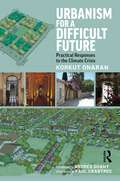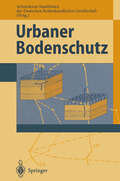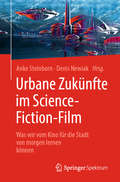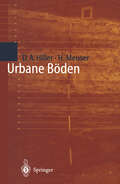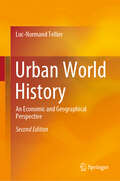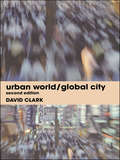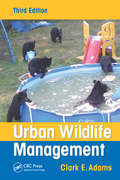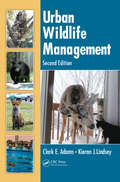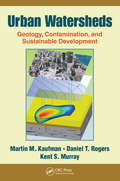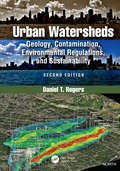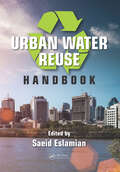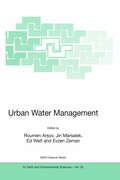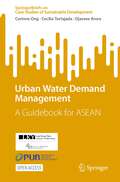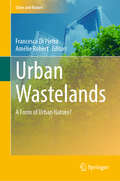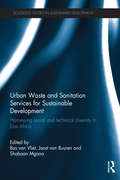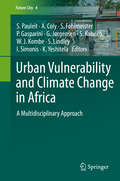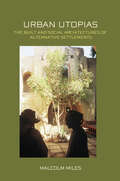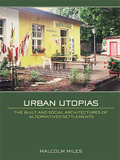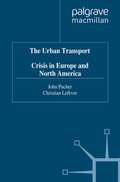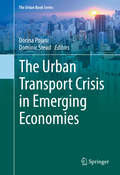- Table View
- List View
Urbanism for a Difficult Future: Practical Responses to the Climate Crisis
by Korkut OnaranUrbanism for a Difficult Future: Practical Responses to the Climate Crisis is a much-needed guide to launching the next generation of land use planning and urbanism that will enable us to adapt to and survive the consequences of climate change. The book offers strong, straightforward measures for creating a landscape of resilience via pockets of self-sufficiencies. It demonstrates how to secure systems that sustain life (energy, water, food, waste, and production of essential goods) as well as political and social protocols enabling agile decision-making in managing these systems effectively at local levels. It also provides the design principles for creating a built environment that will enable the kind of localization we need for adaptation. The book explores how it is possible to create a life that does not depend on large-scale regional sustenance systems which are likely to be disrupted or fail. This book uncovers how to enable people to be creative, productive, and supportive at local levels, so that we can achieve strong and diverse local economies that can sustain life. It will appeal to students, planners, and policy makers working in environmental studies, environmental engineering, urban and regional planning, architecture, landscape architecture, and urbanism.
Urbanism for a Difficult Future: Practical Responses to the Climate Crisis
by Korkut OnaranUrbanism for a Difficult Future: Practical Responses to the Climate Crisis is a much-needed guide to launching the next generation of land use planning and urbanism that will enable us to adapt to and survive the consequences of climate change. The book offers strong, straightforward measures for creating a landscape of resilience via pockets of self-sufficiencies. It demonstrates how to secure systems that sustain life (energy, water, food, waste, and production of essential goods) as well as political and social protocols enabling agile decision-making in managing these systems effectively at local levels. It also provides the design principles for creating a built environment that will enable the kind of localization we need for adaptation. The book explores how it is possible to create a life that does not depend on large-scale regional sustenance systems which are likely to be disrupted or fail. This book uncovers how to enable people to be creative, productive, and supportive at local levels, so that we can achieve strong and diverse local economies that can sustain life. It will appeal to students, planners, and policy makers working in environmental studies, environmental engineering, urban and regional planning, architecture, landscape architecture, and urbanism.
Urbane Zukünfte im Science-Fiction-Film: Was wir vom Kino für die Stadt von morgen lernen können
by Ferdinando TerelleDieses Buch bietet eine außergewöhnliche Perspektive auf die nachhaltige, lebenswerte und humane Gestaltung urbaner Zukünfte, indem es sich dieser Herausforderung mit Blick auf das Science-Fiction-Kino sowie mit Bezügen zu Literatur, Architektur und Design nähert.Schon im Jahr 2050 sollen mehr als zwei Drittel aller Menschen in Ballungsräumen leben. Doch Großstädte laufen bereits heute Gefahr, an ihre Leistungsgrenzen zu stoßen: In den Megacities drohen Überbevölkerung, Verkehrschaos, Luftverschmutzung und Vereinsamung. Auf welche Weise werden solche zukünftig immer drängenderen Probleme in den fiktionalen Welten von Genreklassikern und aktuellen Blockbustern gelöst? Was lässt sich aus den fantastischen Zukunftsentwürfen zur Bewältigung urbaner Herausforderungen lernen?mediale und nachhaltige Großstadt-Architekturen New-Work-Designs und -KonzepteStrategien gegen gesellschaftliche SpaltungZu diesen und anderen Themen zeigen die Autoren eine Vielzahl von Ideen für die Stadtplanung der Zukunft auf und plädieren für das Nutzbarmachen kreativer Potenziale bei der Gestaltung lebenswerter Umgebungen.
Urban World History: An Economic and Geographical Perspective
by Luc-Normand TellierThis book seeks to deepen readers’ understanding of world history by investigating urbanization and the evolution of urban systems, as well as the urban world, from the perspective of historical analysis. The theoretical framework of the approach stems directly from space-economy, and, more generally, from location theory and the theory of urban systems.The author explores a certain logic to be found in world history, and argues that this logic is spatial (in terms of spatial inertia, spatial trends, attractive and repulsive forces, vector fields, etc.) rather than geographical (in terms of climate, precipitation, hydrography). Accordingly, the book puts forward a truly original vision of urban world history, one that will benefit economists, historians, regional scientists, and anyone with a healthy curiosity.
Urban World/Global City
by David ClarkThis book identifies and accounts for the characteristics of the contemporary city and of urban society. It analyzes the distribution and growth of settlements and explores the social and behavioral characteristics of urban living. The latest theoretical and empirical developments and insights are synthesized and presented in an accessible and engaging way.This second edition has been extensively updated and referenced. Each chapter includes sets of learning objectives, annotated readings and topics for discussion. Well-illustrated throughout, it will be essential reading for students of geography, sociology and development studies and all who seek an understanding of how the urban world has evolved and how it will change in the twenty-first century.
Urban World/Global City
by David ClarkThis book identifies and accounts for the characteristics of the contemporary city and of urban society. It analyzes the distribution and growth of settlements and explores the social and behavioral characteristics of urban living. The latest theoretical and empirical developments and insights are synthesized and presented in an accessible and engaging way.This second edition has been extensively updated and referenced. Each chapter includes sets of learning objectives, annotated readings and topics for discussion. Well-illustrated throughout, it will be essential reading for students of geography, sociology and development studies and all who seek an understanding of how the urban world has evolved and how it will change in the twenty-first century.
Urban Wildlife Management
by Clark E. AdamsWinner of the 2018 TWS Wildlife Publication Awards in the authored book category Urban development is one of the leading worldwide threats to conserving biodiversity. In the near future, wildlife management in urban landscapes will be a prominent issue for wildlife professionals. This new edition of Urban Wildlife Management continues the work of its predecessors by providing a comprehensive examination of the issues that increase the need for urban wildlife management, exploring the changing dynamics of the field while giving historical perspectives and looking at current trends and future directions. The book examines a range of topics on human interactions with wildlife in urbanized environments. It focuses not only on ecological matters but also on political, economic, and societal issues that must be addressed for successful management planning. This edition features an entirely new section on urban wildlife species, including chapters on urban communities, herpetofauna, birds, ungulates, mammals, carnivores, and feral and introduced species. The third edition features Five new chapters 12 updated chapters Four new case studies Seven new appendices and species profiles 90 new figures A comprehensive analysis of terrestrial vertebrate locations by state and urban observations Each chapter opens with a set of key concepts which are then examined in the following discussions. Suggested learning experiences to enhance knowledge conclude each chapter. The species profiles cover not only data about the animal concerned but also detail significant current management issues related to the species. An updated and expanded teaching tool, Urban Wildlife Management, Third Edition identifies the challenges and opportunities facing wildlife in urban communities as well as factors that promote or threaten their presence. It gives both students and professionals a solid grounding in the required fundamental ecological principles for understanding the effects of human-made environments on wildlife.
Urban Wildlife Management
by Clark E. AdamsWinner of the 2018 TWS Wildlife Publication Awards in the authored book category Urban development is one of the leading worldwide threats to conserving biodiversity. In the near future, wildlife management in urban landscapes will be a prominent issue for wildlife professionals. This new edition of Urban Wildlife Management continues the work of its predecessors by providing a comprehensive examination of the issues that increase the need for urban wildlife management, exploring the changing dynamics of the field while giving historical perspectives and looking at current trends and future directions. The book examines a range of topics on human interactions with wildlife in urbanized environments. It focuses not only on ecological matters but also on political, economic, and societal issues that must be addressed for successful management planning. This edition features an entirely new section on urban wildlife species, including chapters on urban communities, herpetofauna, birds, ungulates, mammals, carnivores, and feral and introduced species. The third edition features Five new chapters 12 updated chapters Four new case studies Seven new appendices and species profiles 90 new figures A comprehensive analysis of terrestrial vertebrate locations by state and urban observations Each chapter opens with a set of key concepts which are then examined in the following discussions. Suggested learning experiences to enhance knowledge conclude each chapter. The species profiles cover not only data about the animal concerned but also detail significant current management issues related to the species. An updated and expanded teaching tool, Urban Wildlife Management, Third Edition identifies the challenges and opportunities facing wildlife in urban communities as well as factors that promote or threaten their presence. It gives both students and professionals a solid grounding in the required fundamental ecological principles for understanding the effects of human-made environments on wildlife.
Urban Wildlife Management
by Clark E. Adams Kieran J. LindseyWhen the first edition of Urban Wildlife Management was published two years ago, it provided conservationists, ecologists, and wildlife professionals with a welcome shift in the way that interactions between humans and wildlife were viewed and managed. Instead of focusing on ways to evict or eradicate wildlife encroached on by urban development, th
Urban Watersheds: Geology, Contamination, and Sustainable Development
by Martin M. Kaufman Daniel T. Rogers Kent S. MurrayWith the continuing increase in population, more people are sharing the finite resources of the urban watershed, resulting in new and increasingly complex interactions between humans and the environment. Environmental contamination is a chronic problem-and an expensive one. In urban areas, water and soil contamination poses a threat to public healt
Urban Watersheds: Geology, Contamination, Environmental Regulations, and Sustainability, Second Edition
by Daniel T. RogersUnderstanding that the natural world beneath our feet is the point at which civilization meets the natural world is critical to the success of restoration and prevention efforts to reduce contaminant impacts and improve the global environment because of one simple fact – contaminants do not respect country borders. Contaminants often begin their destructive journey immediately after being released and can affect the entire planet if the release is in just the right amount, at just the right location, and at just the right time. Taking an interdisciplinary approach, Urban Watersheds, Geology, Contamination, Environmental Regulations, and Sustainability, Second Edition presents more than 30 years of research and professional practice on urban watersheds from the fields of environmental geology, geochemistry, risk analysis, hydrology, and urban planning. The geological characteristics of urbanized watersheds along with the physical and chemical properties of their common contaminants are integrated to assess risk factors for soil, groundwater, and air. This new edition continues to examine the urban environment and the geology beneath urban areas, evaluates the contamination that affects watersheds in urban regions, and addresses redevelopment strategies. Features of the Second Edition: Examines contaminants and the successes of environmental regulation worldwide and highlights the areas that need improvement Describes several advances in investigation techniques in urban regions that now provide a huge leap forward in data collection, resolution, and accuracy Explains the importance of understanding the geological and hydrogeologic environments of urban and developed regions Provides new and enhanced methods presented as a sustainability model for assessing risks to human health and the environment from negative human-induced contaminant impacts Includes a new chapter that surveys how environmental regulations have been successful or have failed at protecting the air, water, and land in urban areas Suitable for use as a textbook and as a professional practice reference, the book includes case studies on successful and unsuccessful approaches to contaminant remediation as well as practical methods for environmental risk assessment. PowerPoint® presentations of selected portions of the book are available with qualifying course adoption. Daniel T. Rogers is currently the Director of Environmental Affairs at Amsted Industries Inc. in Chicago, Illinois. His writings address environmental geology, hydrogeology, geologic vulnerability and mapping, contaminant fate and transport, urban geology, environmental site investigations, contaminant risk, brownfield redevelopment, and sustainability. He has taught geology and environmental chemistry at Eastern Michigan University and the University of Michigan.
Urban Watersheds: Geology, Contamination, Environmental Regulations, and Sustainability, Second Edition
by Daniel T. RogersUnderstanding that the natural world beneath our feet is the point at which civilization meets the natural world is critical to the success of restoration and prevention efforts to reduce contaminant impacts and improve the global environment because of one simple fact – contaminants do not respect country borders. Contaminants often begin their destructive journey immediately after being released and can affect the entire planet if the release is in just the right amount, at just the right location, and at just the right time. Taking an interdisciplinary approach, Urban Watersheds, Geology, Contamination, Environmental Regulations, and Sustainability, Second Edition presents more than 30 years of research and professional practice on urban watersheds from the fields of environmental geology, geochemistry, risk analysis, hydrology, and urban planning. The geological characteristics of urbanized watersheds along with the physical and chemical properties of their common contaminants are integrated to assess risk factors for soil, groundwater, and air. This new edition continues to examine the urban environment and the geology beneath urban areas, evaluates the contamination that affects watersheds in urban regions, and addresses redevelopment strategies. Features of the Second Edition: Examines contaminants and the successes of environmental regulation worldwide and highlights the areas that need improvement Describes several advances in investigation techniques in urban regions that now provide a huge leap forward in data collection, resolution, and accuracy Explains the importance of understanding the geological and hydrogeologic environments of urban and developed regions Provides new and enhanced methods presented as a sustainability model for assessing risks to human health and the environment from negative human-induced contaminant impacts Includes a new chapter that surveys how environmental regulations have been successful or have failed at protecting the air, water, and land in urban areas Suitable for use as a textbook and as a professional practice reference, the book includes case studies on successful and unsuccessful approaches to contaminant remediation as well as practical methods for environmental risk assessment. PowerPoint® presentations of selected portions of the book are available with qualifying course adoption. Daniel T. Rogers is currently the Director of Environmental Affairs at Amsted Industries Inc. in Chicago, Illinois. His writings address environmental geology, hydrogeology, geologic vulnerability and mapping, contaminant fate and transport, urban geology, environmental site investigations, contaminant risk, brownfield redevelopment, and sustainability. He has taught geology and environmental chemistry at Eastern Michigan University and the University of Michigan.
Urban Water Reuse Handbook
by Saeid EslamianExamining the current literature, research, and relevant case studies, presented by a team of international experts, the Urban Water Reuse Handbook discusses the pros and cons of water reuse and explores new and alternative methods for obtaining a sustainable water supply. The book defines water reuse guidelines, describes the historical and curren
Urban Water Management: Science Technology and Service Delivery (NATO Science Series: IV: #25)
by EvzenZeman EdWatt JiriMarsalek RoumenArsovUrban population growth dramatically alters material and energy fluxes in the affected areas, with concomitant changes in landscape, altered fluxes of water, sediment, chemicals and pathogens and increased releases of waste heat. These changes then impact on urban ecosystems, including water resources and result in their degradation. Such circumstances make the provision of water services to urban populations even more challenging. Changing weather patterns, rising temperature and large variations in precipitation contr- ute to increased damages, caused by weather related disasters, including floods. Ones of the major contributors to increasing flood peaks are land use changes and particularl- urban development. Consequently, there is a need to look for low environmental impact land development and to manage runoff in urban areas by storm water management. Much progress in the management of urban waters has been achieved in the most - vanced jurisdictions, but much more remains to be done. In this respect the EC Water Framework Directive can provide some guidance. Urban water management issues are particularly important in the countries in transition in Central and Eastern Europe. During the last decade political, economical and social changes in the countries under transition have influenced almost every element of the public sector, including water services. There is an urgent need for exchange of information among various countries on this issue and for identification of best approaches to achieving this transition.
Urban Water Demand Management: A Guidebook for ASEAN (SpringerBriefs on Case Studies of Sustainable Development)
by Corinne Ong Cecilia Tortajada Ojasvee AroraThis open access book highlights knowledge and expertise in Urban Water Demand Management (WDM) in ASEAN through comprehensive literature review and analysis, as well as stakeholder consultations. It documents urban WDM policies, initiatives, and practices that have demonstrated effective implementation outcomes across various contexts and which are expected to be relevant for cities in ASEAN. A WDM typology developed for this book identifies four key WDM measures, namely: water losses, economic instruments, non-price mechanisms, and alternative water reuse systems in the ASEAN context. Case illustrations of their effective implementation in different ASEAN cities are also included.
Urban Wastelands: A Form of Urban Nature? (Cities and Nature)
by Francesca Di Pietro Amélie RobertFaced with the growing demand for nature in cities, informal greenspaces are gaining the interest of various stakeholders - residents, associations, public authorities - as well as scientists. This book provides a cross-sectorial overview of the advantages and disadvantages of urban wastelands in meeting this social demand of urban nature, spanning from the social sciences and urban planning to ecology and soil sciences. It shows the potential of urban wastelands with respect to city dwellers’ well-being, environmental education, urban biodiversity and urban green networks as well as concerns regarding urban wastelands’ in relation to conflicts, and urban marketing. The authors provide a global insight through case studies in nine countries, mainly located in Europe, Asia and America, thus offering a broad perspective.
Urban Waste and Sanitation Services for Sustainable Development: Harnessing Social and Technical Diversity in East Africa (Routledge Studies in Sustainable Development)
by Shaaban Mgana Bas Van Vliet Joost Van BuurenUrban sanitation and solid waste sectors are under significant pressure in East Africa due to the lack of competent institutional capacity and the growth of the region’s urban population. This book presents and applies an original analytical approach to assess the existing socio-technical mixtures of waste and sanitation systems and to ensure wider access, increase flexibility and ecological sustainability. It shows how the problem is not the current diversity in waste and sanitation infrastructures and services and variety of types and scales of technology, of formal and informal sector involvement, and of management and ownership modes. The book focuses instead on the lack of an integrative approach to managing and upgrading of the various waste and sanitation configurations and services so as to ensure wider access, flexibility and sustainability for the low income populations who happen to be the main stakeholders. This approach, coined "Modernized Mixtures", serves as a nexus throughout the book. The empirical core addresses the waste and sanitation challenges and debates at each scale - from the micro-level (households) to the macro-level (international support) - and is based on the results of a five-year-long interdisciplinary, empirical research program. It assesses the socio-technical diversity in waste and sanitation and provides viable solutions to sanitation and waste management in East Africa. This book provides students, researchers and professional in environmental technology, sociology, management and urban planning with an integrated analytical perspective on centralized and decentralized waste and sanitation configurations and tools for improvement in the technology, policy and management of sanitation and solid waste sectors.
Urban Waste and Sanitation Services for Sustainable Development: Harnessing Social and Technical Diversity in East Africa (Routledge Studies in Sustainable Development)
by Bas Van Vliet Joost Van Buuren Shaaban MganaUrban sanitation and solid waste sectors are under significant pressure in East Africa due to the lack of competent institutional capacity and the growth of the region’s urban population. This book presents and applies an original analytical approach to assess the existing socio-technical mixtures of waste and sanitation systems and to ensure wider access, increase flexibility and ecological sustainability. It shows how the problem is not the current diversity in waste and sanitation infrastructures and services and variety of types and scales of technology, of formal and informal sector involvement, and of management and ownership modes. The book focuses instead on the lack of an integrative approach to managing and upgrading of the various waste and sanitation configurations and services so as to ensure wider access, flexibility and sustainability for the low income populations who happen to be the main stakeholders. This approach, coined "Modernized Mixtures", serves as a nexus throughout the book. The empirical core addresses the waste and sanitation challenges and debates at each scale - from the micro-level (households) to the macro-level (international support) - and is based on the results of a five-year-long interdisciplinary, empirical research program. It assesses the socio-technical diversity in waste and sanitation and provides viable solutions to sanitation and waste management in East Africa. This book provides students, researchers and professional in environmental technology, sociology, management and urban planning with an integrated analytical perspective on centralized and decentralized waste and sanitation configurations and tools for improvement in the technology, policy and management of sanitation and solid waste sectors.
Urban Vulnerability and Climate Change in Africa: A Multidisciplinary Approach (Future City #4)
by Stephan Pauleit Adrien Coly Sandra Fohlmeister Paolo Gasparini Gertrud Jørgensen Sigrun Kabisch Wilbard J. Kombe Sarah Lindley Ingo Simonis Kumelachew YeshitelaUrbanisation and climate change are among the major challenges for sustainable development in Africa. The overall aim of this book is to present innovative approaches to vulnerability analysis and for enhancing the resilience of African cities against climate change-induced risks. Locally adapted IPCC climate change scenarios, which also consider possible changes in urban population, have been developed. Innovative strategies to land use and spatial planning are proposed that seek synergies between the adaptation to climate change and the need to solve social problems. Furthermore, the book explores the role of governance in successfully coping with climate-induced risks in urban areas. The book is unique in that it combines: a top-down perspective of climate change modeling with a bottom-up perspective of vulnerability assessment; quantitative approaches from engineering sciences and qualitative approaches of the social sciences; a novel multi-risk modeling methodology; and strategic approaches to urban and green infrastructure planning with neighborhood perspectives of adaptation.
Urban Utopias: The Built and Social Architectures of Alternative Settlements
by Malcolm MilesUtopia tends to generate a bad press - regarded as impracticable, perhaps nostalgic, or contradictory when visions of a perfect world cannot accommodate the change that is necessary to a free and self-organizing society. But people from diverse backgrounds are currently building a new society within the old, balancing literal and metaphorical utopianism, and demonstrating plural possibilities for alternative futures and types of settlement. Thousands of such places exist around the world, including intentional communities, eco-villages, permaculture plots, religious and secular retreats, co-housing projects, self-build schemes, projects for low-impact housing, and activist squats in urban and rural sites. This experience suggests, however, that when planning and design are not integral to alternative social formations, the modern dream to engineer a new society cannot be realized. The book is structured in four parts. In part one, literary and theoretical utopias from the early modern period to the nineteenth-century are reconsidered. Part two investigates twentieth-century urban utopianism and contemporary alternative settlements focusing on social and environmental issues, activism and eco-village living. Part three looks to wider horizons in recent practices in the non-affluent world, and Part four reviews a range of cases from the author’s visits to specific sites. This is followed by a short conclusion in which a discussion of key issues is resumed. This book brings together insights from literary, theoretical and practical utopias, drawing out the characteristics of groups and places that are part of a new society. It links today’s utopian experiments to historical and literary utopias, and to theoretical problems in utopian thought.
Urban Utopias: The Built and Social Architectures of Alternative Settlements
by Malcolm MilesUtopia tends to generate a bad press - regarded as impracticable, perhaps nostalgic, or contradictory when visions of a perfect world cannot accommodate the change that is necessary to a free and self-organizing society. But people from diverse backgrounds are currently building a new society within the old, balancing literal and metaphorical utopianism, and demonstrating plural possibilities for alternative futures and types of settlement. Thousands of such places exist around the world, including intentional communities, eco-villages, permaculture plots, religious and secular retreats, co-housing projects, self-build schemes, projects for low-impact housing, and activist squats in urban and rural sites. This experience suggests, however, that when planning and design are not integral to alternative social formations, the modern dream to engineer a new society cannot be realized. The book is structured in four parts. In part one, literary and theoretical utopias from the early modern period to the nineteenth-century are reconsidered. Part two investigates twentieth-century urban utopianism and contemporary alternative settlements focusing on social and environmental issues, activism and eco-village living. Part three looks to wider horizons in recent practices in the non-affluent world, and Part four reviews a range of cases from the author’s visits to specific sites. This is followed by a short conclusion in which a discussion of key issues is resumed. This book brings together insights from literary, theoretical and practical utopias, drawing out the characteristics of groups and places that are part of a new society. It links today’s utopian experiments to historical and literary utopias, and to theoretical problems in utopian thought.
The Urban Transport Crisis in Europe and North America
by J. Pucher C. LefevreIncreasing levels of auto ownership and use are causing severe social, economic, and environmental problems in virtually all countries in Europe and North America. This book documents the worsening transport crisis and differences among countries in their urban transport and land-use systems. The focus is on public policies to deal with urban transport problems. Through in-depth case studies of eight countries, the book seeks to evaluate the effectiveness of alternative solutions to transport problems, and thus a way out of the transport crisis.
The Urban Transport Crisis in Emerging Economies (The Urban Book Series)
by Dorina Pojani Dominic SteadThis edited volume discuses urban transport issues, policies, and initiatives in twelve of the world’s major emerging economies – Brazil, China, Colombia, India, Indonesia, Iran, Mexico, Nigeria, Russia, South Africa, Turkey, and Vietnam - countries with large populations that have recently experienced large changes in urban structure, motorization and all the associated social, economic, and environmental impacts in positive and negative senses. Contributions on each of these twelve countries focus on one or more major cities per country. This book aims to fill a gap in the transport literature that is crucial to understanding the needs of a large portion of the world’s urban population, especially in view of the southward shift in economic power. Readers will develop a better understanding of urban transport problems and policies in nations where development levels are below those of richer countries (mainly in the northern hemisphere) but where the rate of economic growth is often increasing at a faster rate than the wealthiest nations.
